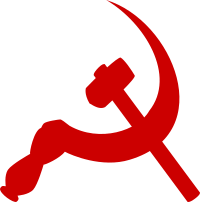
Back Militarizado Partido Comunista del Perú Spanish ペルー人民解放軍 Japanese Militarizado Partido Comunista do Peru Portuguese 秘鲁军事化共产党 Chinese
| Militarized Communist Party of Peru | |
|---|---|
| Militarizado Partido Comunista del Perú | |
 | |
| Also known as |
|
| Leader | Comrade José |
| Dates of operation | 1992–present[note 1] |
| Split from | Shining Path |
| Allegiance | |
| Active regions | VRAEM |
| Ideology | |
| Political position | Far-left |
| Major actions | Involvement in the communist insurgency in Peru through the use of: |
| Status | Active |
| Allies | (claimed by MPCP) (2018–2022) |
| Opponents | |
| Battles and wars | Internal conflict in Peru |
| Flag |  |
The Militarized Communist Party of Peru (Spanish: Militarizado Partido Comunista del Perú, MPCP;[note 2] formerly known as SL-Proseguir) is a political party and militant group in Peru that follows Marxism–Leninism–Maoism and participates in the communist insurgency in Peru. It is considered a terrorist organization by the government of Peru. The MPCP operates primarily in the VRAEM area and is involved in the area's coca production.[3] Comrade José has been the leader of the MPCP since its official creation in 2018 after its final split from the declining Shining Path guerilla group.[4]
The MPCP originated in the 1990s as Sendero Luminoso-Proseguir (Shining Path-Onward, SL-Proseguir), forming after the capture of Abimael Guzmán. The party is considered the direct successor to the Shining Path by the government of Peru and other international entities [citation needed], because most of its members splintered from the Shining Path in 1992. Ideologically, the group brands itself as a Maoist party, although its beliefs differ greatly from those of the Shining Path.[5][need quotation to verify] The MPCP has maintained contact with Andean ultranationalist groups tied with the ethnocacerist movement.[6] In 2018, the MPCP formed an alliance with the Plurinational Association of Tawantinsuyo Reservists, an ethnocacerist group, called the United Democratic Andean Revolutionary Front of Peru (Spanish: Frente Unido Democrático Andino Revolucionario del Perú).[6] Diverging from other Maoist parties, the MPCP has voiced support for the modern-day Communist Party of China and its general secretary Xi Jinping.[7][1] The group has distanced itself from the Gonzalo Thought ideology and anti-religious stance of the Shining Path.[4]
The MPCP has stated that it severed its ties with the leader of the Shining Path, Abimael Guzmán, after his capture in 1992 and subsequent call for peace in 1993. However, the MPCP itself has been accused of utilizing similar tactics to those of Guzmán, including slavery of indigenous peoples,[8][need quotation to verify] recruitment of children for use as child soldiers,[9] and terrorist attacks against civilians and members of the Peruvian government, among other human rights violations. The Peruvian military said that the group was responsible for the San Miguel del Ene attack on 23 May 2021, which resulted in the deaths of 18 people in the Satipo Province of Peru.[10][11]
Cite error: There are <ref group=note> tags on this page, but the references will not show without a {{reflist|group=note}} template (see the help page).
- ^ a b Jiménez, Benedicto (26 February 2023). "La conversión del Militarizado Partido Comunista Peruano autor Benedicto Jiménez. - Issuu". issu. Archived from the original on 26 February 2023. Retrieved 12 May 2023.
- ^ "Sendero Luminoso sufre deserciones por estrategia militar y policial en el Vraem". gob.pe. Gobierno del Perú. 21 February 2020. Retrieved 27 May 2021.
- ^ "Peru's Shining Path Plots Unlikely Return to Power". InSight Crime. 23 September 2019. Retrieved 27 May 2021.
- ^ a b "Terrorista "José" amenaza con más ataques a las fuerzas del orden". La República (in Spanish). 9 June 2018. Retrieved 27 May 2021.
- ^ Sputnik (23 August 2019). "Guerrilla maoísta Sendero Luminoso ya no existe en Perú, asegura especialista". Diario Digital Nuestro País/El País (in Spanish). Retrieved 27 May 2021.
- ^ a b "El Militarizado PC mantiene contactos con exmilitares ultranacionalistas". La Vanguardia (in Spanish). 13 June 2018. Retrieved 27 May 2021.
- ^ "La Conversión Del Grupo Narcoterrorista Del VRAEM AL MLM Siismo SIISMO by Benedicto Jiménez 1509". issuu.com. Retrieved 12 May 2023.
- ^ Leon, Ricardo (13 February 2020). "Policías y militares buscan al menos 10 terroristas armados que desertaron en el Vraem". El Comercio (in Spanish). Retrieved 27 May 2021.
- ^ Meza, Junior (7 March 2019). ""Somos conscientes de las matanzas [de Sendero en el Vraem], eso no puede quedar impune"". Ojo Público (in Spanish). Retrieved 27 May 2021.
- ^ "Asesinadas 18 personas en un posible ataque de Sendero Luminoso". www.europapress.es. Europa Press. 24 May 2021. Archived from the original on 25 May 2021. Retrieved 24 May 2021.
- ^ "Violencia en el valle de la droga: grupo narcoterrorista de 'José' es acusado de acribillar a 16 personas". OjoPúblico (in Spanish). 24 May 2021. Retrieved 6 June 2023.